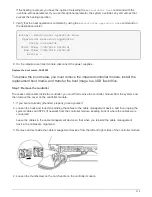
8. Give back the controller using the
storage failover giveback -fromnode local
command.
9. At the cluster prompt, check the logical interfaces with the
net int -is-home false
command.
If any interfaces are listed as "false", revert those interfaces back to their home port using the
net int
revert
command.
10. Move the console cable to the repaired controller and run the
version -v
command to check the ONTAP
versions.
11. Restore automatic giveback if you disabled it by using the
storage failover modify -node local
-auto-giveback true
command.
Option 2: Controller is in a two-node MetroCluster
You must boot the ONTAP image from the USB drive and verify the environmental variables.
This procedure applies to systems in a two-node MetroCluster configuration.
Steps
1. From the LOADER prompt, boot the recovery image from the USB flash drive:
boot_recovery
The image is downloaded from the USB flash drive.
2. When prompted, either enter the name of the image or accept the default image displayed inside the
brackets on your screen.
3. After the image is installed, start the restoration process:
a. Press
n
when prompted to restore the backup configuration.
b. Press
y
when prompted to reboot to start using the newly installed software.
You should be prepared to interrupt the boot process when prompted.
4. As the system boots, press
Ctrl-C
after you see the
Press Ctrl-C for Boot Menu
message., and
when the Boot Menu is displayed select option 6.
5. Verify that the environmental variables are set as expected.
a. Take the node to the LOADER prompt.
b. Check the environment variable settings with the
printenv
command.
c. If an environment variable is not set as expected, modify it with the
setenv
environment-
variable-name
changed-value
command.
d. Save your changes using the
savenv
command.
e. Reboot the node.
Switch back aggregates in a two-node MetroCluster configuration - FAS8200
After you have completed the FRU replacement in a two-node MetroCluster
configuration, you can perform the MetroCluster switchback operation. This returns the
configuration to its normal operating state, with the sync-source storage virtual machines
(SVMs) on the formerly impaired site now active and serving data from the local disk
pools.
321






























